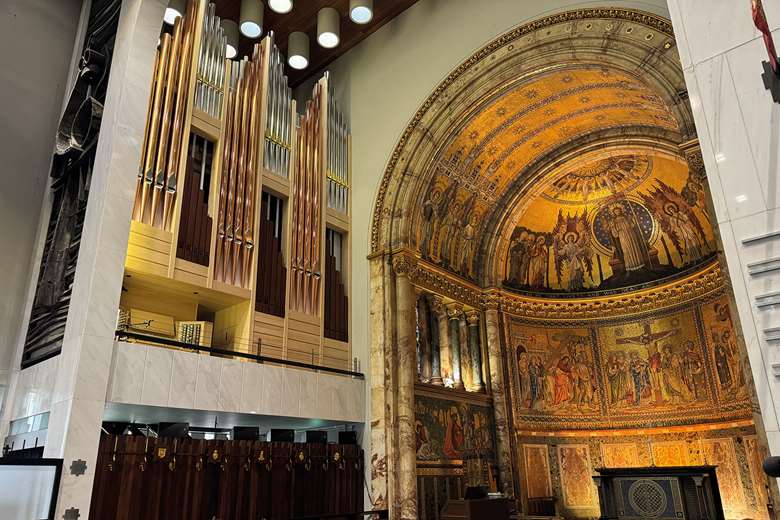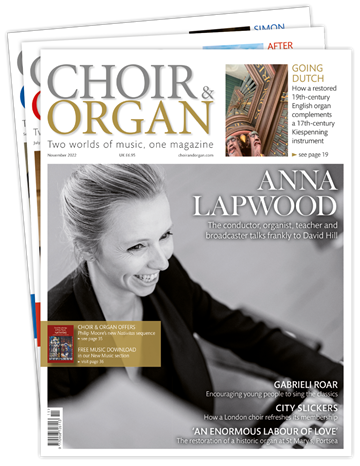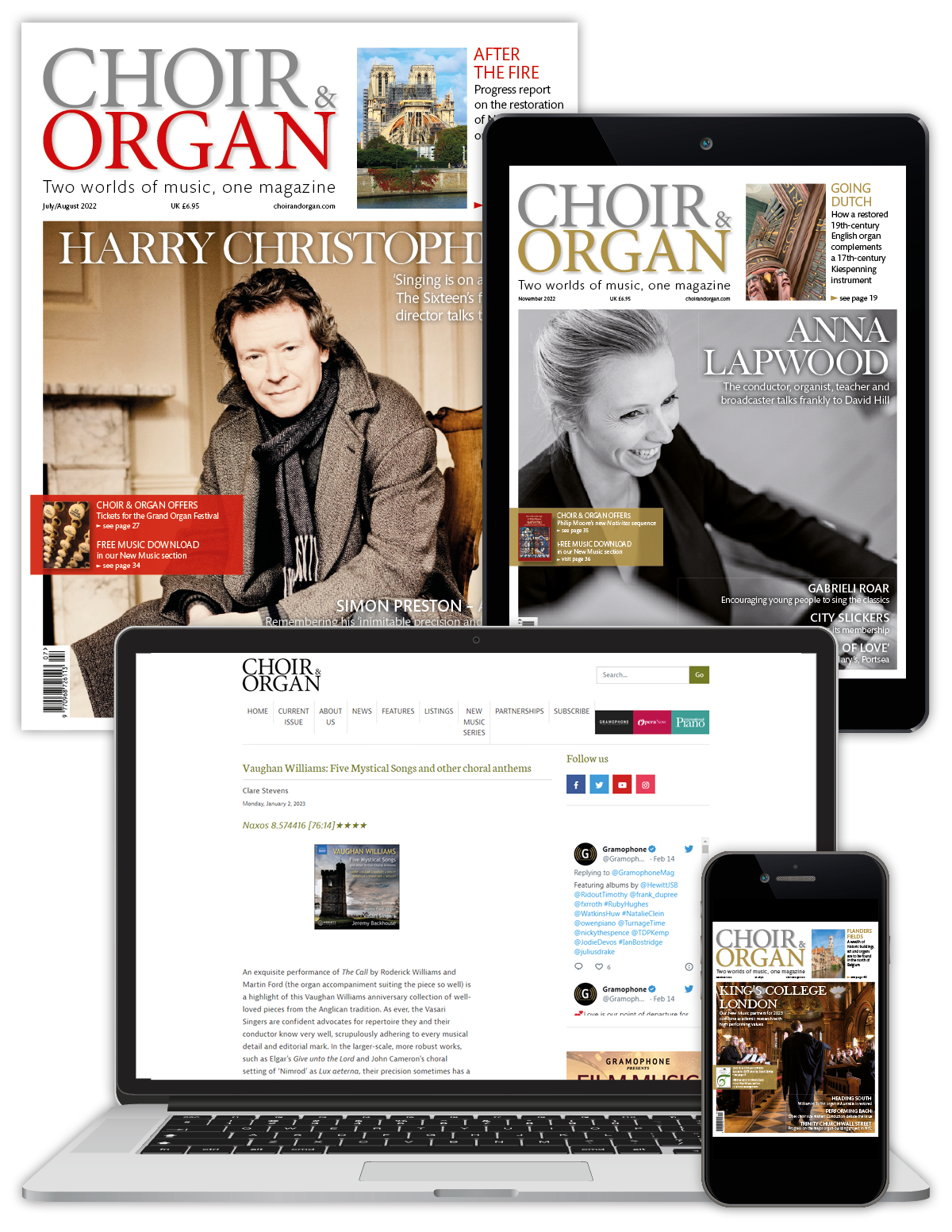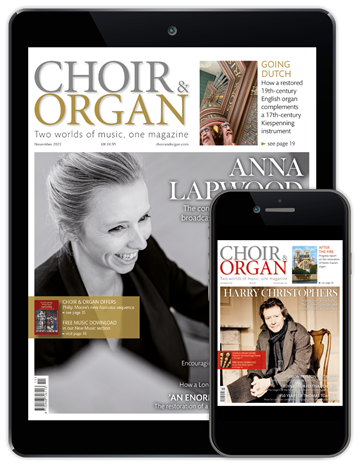A close look at Harrison & Harrison’s new organ for The Guards’ Chapel, Wellington Barracks
Nicholas Thistlethwaite
Thursday, August 29, 2024
The visual impact and ingenious tonal design of Harrison & Harrison’s new organ for The Guards’ Chapel brings another landmark instrument to central London. Nicholas Thistlethwaite reviews the work

Wellington Barracks occupies an extensive site to the south of St James’ Park, squeezed between Birdcage Walk and Buckingham Gate. The main range of buildings dates from the 1830s and includes The Royal Military Chapel (The Guards’ Chapel). The Chapel was remodelled in 1879 by G E Street, who added a half-domed apse with glowing mosaics designed by Clayton and Bell. Most of the building was destroyed by a flying bomb in 1944 and was rebuilt in an unapologetically Modernist style to the design of Bruce George (1963) with a wide narthex and nave, a chancel with galleries, and culminating still in Street’s splendid apse which had somehow survived the destruction. It is a spacious, light-filled interior which, when empty, has a mildly resonant acoustic which no doubt diminishes when the building is filled with uniformed personnel.
The previous organ was built by Hill, Norman & Beard in 1976, making use of soundboards, pipes and other components from the extraordinary instrument installed by the firm in the music room at Glyndebourne between 1920 and 1926. Using extended ranks and the borrowing of manual registers to the Pedal, the Glyndebourne organ eventually boasted more than one hundred stops. Its smaller descendant in The Guards’ Chapel had 36 speaking stops, including en chamade trumpets of 8 and 4ft pitch located in the south chancel gallery, and digital 32ft stops added during an overhaul in 1992.
The judgement must be that this is an impressive addition to central London’s stock of pipe organs
Discussions about the future of the ailing Hill, Norman & Beard organ began in 2015, leading to a decision to replace it with a new instrument. Dr William McVicker was appointed as the consultant, and a musical rationale was prepared to guide potential contractors in drawing up their proposals. It described an instrument which would be able to accompany the chapel’s 12-voice professional choir which sings on Sunday mornings, and at a variety of occasional offices, concerts and regimental services over the course of the year: regular repertoire includes Mozart masses, and settings and anthems by the standard Victorian and Edwardian composers, as well as more modern names such as Britten, Dove, Ives and Philip Moore; able to work with and underpin the military bands that form a regular part of the chapel’s musical life, at both services and concerts; able to lead congregational singing with and without military bands; a colourful solo instrument; an instrument that would be a resource for the chapel’s wider engagement with the community, including masterclasses and composite recitals for young organists; a visual enhancement of the chapel’s interior, able to bridge its two architectural styles.
The musical programme encompasses a wide variety of repertoire. The regular use of the organ with military bands was a particular (and unusual) consideration. William McVicker comments:
‘The bands are remarkably loud. The organ does not necessarily need to overpower them, but it does need to add weight of tone – gravitas, if you like – and have a fullness which fills out the band’s musical textures rather than overpowering them … composers don’t want brilliant mixtures in such textures, but want weight of tone. Elgar sometimes says “organ 32.16.8” which gives an idea of what’s needed.’
All in all, the brief was both an interesting challenge and a splendid opportunity for potential contractors to demonstrate how they would approach the comparatively rare chance of creating a wholly new organ in central London.
Three contractors were shortlisted and each presented their proposals. In the event, the contract was placed with Harrison & Harrison Ltd. Their carefully detailed scheme was for ‘a medium-sized, three-manual organ with four manual divisions, two enclosed and two unenclosed, together with a sizeable Pedal Organ.’ This encompassed a generously-scaled Primary Great chorus for congregational and band use; a smaller Secondary Great chorus for choir accompanimental use; a traditional English Romantic Swell, with a solid chorus building to full swell, enclosed in a box with two independent sets of shutters, to facilitate a wide dynamic range; a small, but colourful Orchestral division, enclosed and capable of adding dynamic drama; a variety of foundational Pedal stops to support the different dynamic levels and musical colours within the organ, and with weight to underpin the manual doubles and sub octave couplers.
The result was an ingenious 40-stop specification in which the maximum flexibility is achieved using manual transfer couplers, and octave/sub octave couplers, to enable the player to configure the instrument in a variety of ways to meet the demands of particular solo and choral repertoires. For example, the Secondary Great can be transferred to the Orchestral (the lowest keyboard) where it functions very effectively as a Positive or Choir division in conjunction with the Primary Great. The Orchestral Organ can be transferred to the Swell keyboard (or vice-versa) to create an enhanced accompanimental division, offering both a ‘small’ full swell based on the Corno di Bassetto 16 and a ‘large’ full swell with the Double Trumpet 16 and its companion reeds. These splendid Swell reeds can be coupled independently to both the Orchestral and the Pedal divisions. The Orchestral Organ which, on paper, looks fairly modest in scope therefore proves to have hidden possibilities, transcending its role as a quasi-Solo division.
Tonally, the instrument handsomely fulfils the promise of its specification. The build-up from Swell strings to full organ, crowned with the Orchestral Trumpet, is beautifully managed and quite thrilling. The voicing of individual flue registers is exemplary (the Claribel Flute, Flûte Harmonique, Violoncello and Gedeckt are particularly characterful), and the reeds are outstanding – the broad-toned Posaune on the Great which colours the full flue chorus without overwhelming it; the smooth and bright chorus of trumpets on the Swell; the triumphant Orchestral Trumpet, and a Pedal reed unit (32 and 16ft) which is primarily a chorus register but is still bold enough to make its presence felt in the final bars of a French symphonie, Liszt’s B-A-C-H, or one of Elgar’s Pomp and Circumstance marches. Meanwhile, the creamy Corno di Bassetto 16 (equipped with an extra octave of pipes so that it can be used as an 8ft solo stop) and Swell Hautboy 8 both complement, and contrast with, one another.

Pipes of the Swell 8ft Hautboy (Andrew Scott/Harrison & Harrison)
Although the tonal character of the new organ is predominantly English Romantic, it will cope admirably with a wide selection of solo and choral repertoire. The Secondary Great and the Swell offer a range of registrations for trio sonatas, sets of variations (Sweelinck, Bach) and chorale preludes with the colourful mutations also capable of providing some of the prescribed registrations required by the French Classical repertoire. The flue chorus of the Great Organ has a boldness and clarity which might have been inspired by the work of T C Lewis; with its bright, but perfectly integrated Mixture IV, and supported by the generously-scaled Pedal Organ, it will accompany congregational singing splendidly, even when partnered by a military band. The same chorus, with appropriate Pedal registrations, also works convincingly for the major compositions of (among many others) Bach, Mendelssohn and Franck, deploying the Secondary Great, or the Swell flue chorus, or a combination of the two to provide a secondary chorus when needed.
The new organ case makes a striking contribution to the interior of the chapel. The challenge of bridging the aesthetic divide between Street’s apse and the 1960s’ nave and chancel has been skilfully addressed with a case front designed by Harrison & Harrison, with input from the architect Jonathan Louth; it consists of three groups of large copper pipes, interspersed with high tin-content pipes with gilded mouths at the upper level, and wooden pipes at the lower level placed in front of the chancel shutters of the Swell. The rich effect of the polished copper and tin pipes creates a very effective transition from west to east.
The organ console is of the meticulous standard we have come to expect from Harrison & Harrison, and as can be seen from the specification, it is generously equipped with accessories to increase further the flexibility of the instrument.
The judgement must be that this is an impressive addition to central London’s stock of pipe organs. It is also a fascinating illustration of the ways in which Harrison & Harrison have brought the insights and understanding they have gained from their work on a succession of reconstructions of major English organs to the design and realisation of a totally new instrument. Particularly impressive is the way in which they have achieved musical versatility without sacrificing a well-integrated tonal scheme. It augurs well for the future.
Thanks to Martin Ford, organist and director of music at The Royal Military Chapel, for facilitating this visit, Tammas Slater for assistance at the console, and to assistant organist Ben Giddens for additional photographs.
Nicholas Thistlethwaite is a musical historian and organ consultant who has written extensively about English organs and church music. His book Organ Building in Georgian and Victorian England: the work of Gray & Davison, 1772-1890 was published by The Boydell Press in February 2020
This article originally appeared in the Autumn 2024 issue of Choir & Organ. Never miss an issue – subscribe today






